2020-04-17 15:36:57
Reference material is a kind of national standard measurement for measuring goods, which has been widely used in chemical measurement, biological measurement and other fields. In this rapidly developing economic era, the state has standardized authoritative provisions for the measurement of some items, whether we are in work or life, we must follow the prescribed measurement methods to implement.
As a "measuring tool" in the analysis and measurement industry, the standard material plays an indispensable role in the calibration of measuring instruments and devices, the evaluation of measurement and analysis methods, the measurement of the characteristic value of substances or materials and the assessment of the operating technical level of analysts, as well as the quality control of products in the production process.
The standard material used for verification is generally refrigerated between 0 ° C and 10 ° C, but relative to the transportation of the product, not all the transportation temperature of the product is consistent with the storage temperature, the temperature of freezing storage is below 0 ° C, some of the standard material used for verification has the possibility of temporary warming in transportation, and the special requirements of individual products will be refrigerated transportation.
According to the basic theory of reference material for verification, when measuring and determining the characteristic value of reference material for verification, the measurement uncertainty of the value is composed of three independent components. These are: the measurement uncertainty component introduced by the measurement method, the measurement uncertainty component introduced by the non-uniformity from bottle to bottle, and the measurement uncertainty component introduced by the sample instability over time.

The standard substances used for verification are defined as follows:
(1) Materials or substances having one or more sufficiently uniform and well defined characteristic values for calibrating equipment, evaluating lateral measurement methods or assigning values to materials.
(2) Certified reference material with a certificate for the verification of the reference material, one or more of its characteristic values are determined by establishing traceability procedures, so that it can be traced to the accurate reproduction of the unit of measurement used to represent the characteristic value, and each standard value is accompanied by a given confidence level of uncertainty.
(3) standard substances for verification This is a relatively new concept, the International Committee on Metrology in 1993 established the Quality Advisory Committee, in 1995 the quality Advisory Committee meeting proposed the following definition:
The benchmark method is a measurement method with high metrological quality, its operation can be fully described and understood, its uncertainty can be expressed in SI units, and the measurement result does not depend on the measurement standard being measured.
The above content is the introduction of the standard substance is well known, the standard substance is relatively practical, can be applied well in the actual working conditions, so that it can be used to calibrate the measurement instrument, and then evaluate the accuracy of the measurement method, but also can be used for the quality evaluation of the measurement process and laboratory measurement certification and measurement arbitration.





